
|   |

|   |
Debadhara Award Festival 2016 - Nita Vidyarthi e-mail: nitavidyarthi@gmail.com Photos courtesy: Debadhara September 10, 2016 As a tribute to the legendary Odissi Guru Debaprasad Das, Debadhara, New Delhi, under the guidance of young Odissi guru Binayak Panda, has been organizing an Award Festival in the memory of the maestro regularly since 2014. The third edition of the two day award ceremony and festival of Indian dance forms was organized (August 13 & 14, 2016) at the India International Centre, New Delhi where nine distinguished dancers of the country from diverse dance styles were honoured. Binayak Panda, brother and disciple of Guru Gajendra Panda, must be congratulated for the zeal with which he strives to promote the iconic guru’s style by teaching, facilitating workshops, lecture demonstrations and festivals for better understanding of the “synthetic gharana” imbibing tribal, folk and classical dance forms of Odisha. The award ceremony each evening was followed by performances by the respective dancers and their groups. Day 1 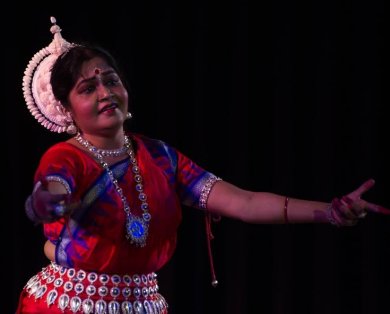 Sasmita Pal 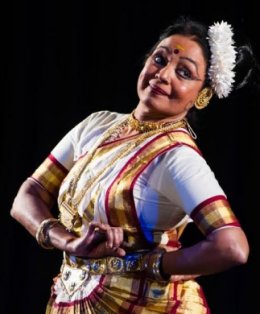 Bharati Shivaji After the inauguration by dignitaries, the evening opened with Pushpanjali and Vishnu Vandana in raag Pahari choreographed by Guru Gajendra Panda, by the female dancers of Debadhara, followed by the award ceremony. The awardees of the first evening were Bharati Shivaji, Geeta Mahalik, Jayalakshmi Eshwar, Ranjumoni Saikia and Sasmita Pal (Singapore).The opening performance was Sasmita Pal’s Sivashtakam “Vande Shambhu Umapatim,” a masterpiece of Guru Debaprasad Das adorned with Shabdaswarapata. Sasmita, although a trained dancer, did not quite discover the power and mood embedded in the slokas and projected an aggressive performance, losing body balance at times. Bharati Shivaji was at her usual best in the invocatory “Bala Ganapati” set to adi tala and Ragamalika. The dalliance of Shiva and Parvati as male and female elephants together with little Ganesha with Devi Saraswati joining them in the forest was expressive with graceful swaying hand movements depicting the trunk of an elephant. In keeping with the age-old tradition of presenting ashtapadis in Kerala set to Sopanam music, Bharati presented “Rati sukha sarey” focusing on the sensuousness of the verse with enchanting lasya, especially the line “na kuru nitambini...”. 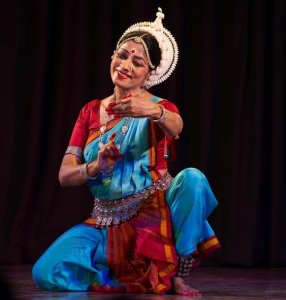 Geeta Mahalik 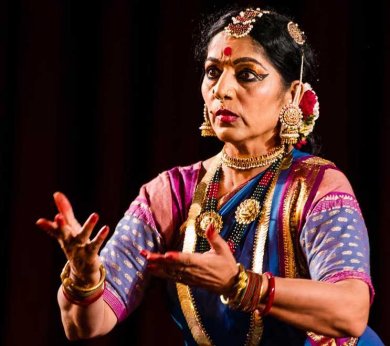
Jayalakshmi Eshwar
Geeta Mahalik presented two unforgettable romantic and sensuous Odiya abhinaya, beginning with a tender padavali “Sajanigo na jani pirati jaha kohey” penned by Banamali Das set to raga Kalashree, adi tala, sung soulfully by Rakhal Mohanty. The Krishnaleela in “Maiya mohey dao bahut khijao” in ektali Ragamalika set to Bankim Sethi’s music came alive with the expressional dancing of the seasoned dancer. The tension lying in searching the waters of Yamuna and subsequently killing the serpent Kaaliya were fine moments composed of despair, anxiety and a final triumph. In spite of a technical glitch with the CD halting several times at the beginning of the lovely Hamsadhwani “Jaya Tungatarangini Gangey,” the Bharatanatyam in adi tala of acclaimed dancer Jayalakshmi Eshwar portraying the Ganga flowing through the Himalayas was a riveting performance composed by Sadashiva Brahmendra. Surdas padavali “Mohey” was an emotional depiction of the khandita nayika taken from the musical score of O.S.Sridhar where the line “Kaha gayi sakhi bawari” unfurled a delightful rhythmic exposition of nritta. What inspired in Eshwar’s dancing were the movement of the eyes and the dynamism of her style. 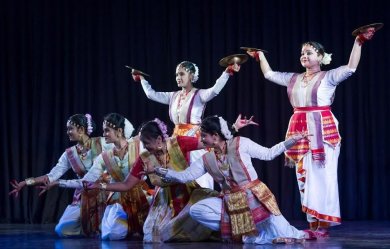 Ranjumoni Saikia & group The popularity of Sattriya is growing fast especially outside the state and Ranjumoni Saikia and her group from Guwahati entertained the Delhi audience with four slokas of “Krishna Vandana” generally sung in Ankiya Bhaona. The traditional “Hari Dhwani” ushered in “Yet pada pankaja” and “Namoh Krishna Yashodanandachakray” in chutkala taal. “Megha Shyamala Murthy” was a lovely group number. The imagery of lifting the Govardhana mountain to save the people of Brindavan from seven days of rain in the concluding “Krishna Basudevaya Devakinandan” was received well by the audience. The group showed fairly good training and coordination but Ranjumoni looked tired even though she put up a fine presentation. In festivals of this kind, it is expected that all the dancers in the group be of the same standard and this was a heterogeneous one. Attention to the lustre of the costumes is needed for better appeal. Day 2 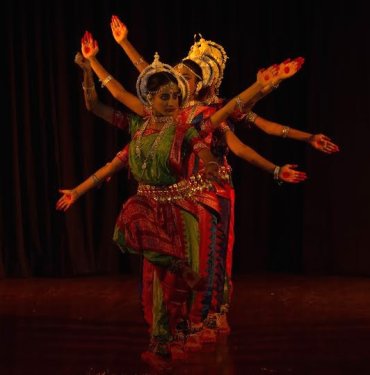 Debadhara group  Manju Elangbam’s group 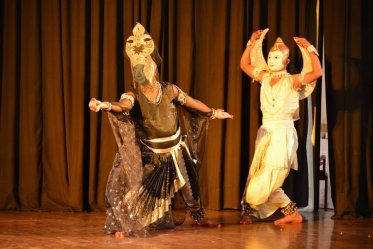 Shashadhar Acharya & group  Rani Khanam The awardees of the second day were Gajendra Panda (Odissi), Shashadhar Acharya (Chhau), Rani Khanam (Kathak) and Manju Elangbam (Manipuri). The evening opened with the invocatory Pushpanjali, “Mahakali Tandava” and an impressive Ram bhajan “Bhaja Ramnaam pada bara bara kori” by the Debadhara group, composed by the Daskathi guru Pt Baidyanath Sharma and choreographed by Gajendra Panda in ektali / Misra Piloo, followed by the award ceremony for the four acclaimed dancers. 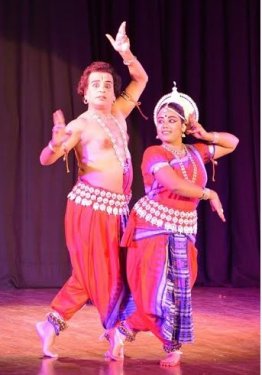 The first performance was ‘Ardhanareswar’ by Guru Gajendra Panda and Diptimoyee Sahu. This piece in raga Malaba Kaushiki, taal triputa and ektali is a signature piece of Gajendra Panda and can be watched again as it is presented with the same classicism, energy and power whether as solo or duet with any dancer. Diptimoyee Sahu is a fine dancer and matched her movements very well with Panda. The refrain of raga Yaman in the shehnai ushered in the Seraikella Chhau performance of ‘Raatri’ in 12 matra by Guru Shashadhar Acharya and his group. Shashadhar accompanied by his brothers Swapan and Ranjit on the dhol and cymbals and son Soham on the nagada put up a gripping performance of the popular piece where the deep involvement between the night (Shashadhar) and the moon (another brother Sukanta) is tenderly displayed. With the subtle music of raga Maru Bihag on the shehnai, ‘Raatri’ grasps and tries to remove all the evils. The artistic ability of the guru to mirror the character with long, strong strides, though restricted due to the small stage, was undoubtedly gratifying. ‘Garuda Basuki,’ the tale of the golden bird and the multi-headed serpent was also captivating projecting the skill of Pulkit Gupta as Garuda and Kishore Bisht as Basuki. An engaging Kathak performance by Rani Khanam beginning with “Yamuna Ashtakam” portraying Yamuna’s arrival at Triveni proved that she was no ordinary dancer. Her sharpness and strength was observed in the chakkar embellished Bageshwari Tarana in jhap taal but the crowning glory was the thumri “Rehematey ahaat hain yaar ki.” Manju Elangbam has a record of 26 hours of non-stop dancing! This handsome young Manipuri dancer garlanded the invocatory ‘Vishnu Vandana’ with a number of ashtapadis from Gita Govinda in his sparkling presentation ‘Krishna Saranam Abhinaya.’ He has a fantastic stage presence and his solo Dasavatar was executed with strong yet delicate strides, presented with command over supreme grace. Ashtapadis like ‘Haririha mugdha,” “Chandana charchita,” “Badasi yadi kinchidapi,” “Smaragaralakhandanam” were performed elegantly with refined grace by his group. Even though Radha disappointed with a blank face, the audience loved the scintillating costumes. Credit is due to Binayak Panda for his single handed effort in organizing this annual award ceremony in memory of the iconic Guru Debaprasad Das. Dr. Nita Vidyarthi is a veteran critic of performing arts and writes on dance, music and theatre in leading publications. |